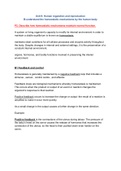Unit 9: Human regulation and reproduction
B:understand the homeostatic mechanisms by the human body
P2: Describe how homeostatic mechanisms maintain normal function.
A system or living organism's capacity to modify its internal environment in order to
maintain a stable equilibrium is known as homeostasis.
maintains ideal conditions for all cellular processes and enzyme activity throughout
the body. Despite changes in internal and external settings, it is the preservation of a
constant internal environment.
organs, hormones, and bodily functions involved in preserving the interior
environment
B1 Feedback and control
Homeostasis is generally maintained by a negative feedback loop that includes a
stimulus , sensor , control centre , and effector.
Feedback loops are biological mechanisms whereby homeostasis is maintained.
This occurs when the product or output of an event or reaction changes the
organism's response to that reaction.
Positive feedback occurs to increase the change or output: the result of a reaction is
amplified to make it occur more quickly.
As a small change in the output causes a further change in the same direction.
Example:
Positive feedback is the contractions of the uterus during labour. The pressure of
the baby’s head on the cervix causes the release of hormones that increases the
contraction of the uterus, so the head is then pushed down even harder on the
cervix.
,Negative feedback serves to reduce an excessive response and to keep a variable
within the normal range. Negative feedback loops control body temperature and the
blood glucose level.
Positive and negative feedback loops, to include the part played by:
• Set point : (A physiologically optimum value for a given biological variable such as
body temperature).
There is a particular set point that is the physiological optimum value. The set point
for human body temperature, for example, is about 37 degrees Celsius. As the body
works to maintain homeostasis for temperature or any other internal variable, the
value typically fluctuates around the set point. Such fluctuations are normal, as long
as they do not become too extreme.
• The receptor receives information that something in the environment is changing.
The control centre or integration centre receives and processes information from the
receptor.
This ongoing process continually works to restore and maintain homeostasis. For
example, during body temperature regulation, temperature receptors in the skin
communicate information to the brain (the control centre) which signals the effectors:
blood vessels and sweat glands in the skin.
• Coordination centres in the brain, spinal cord and pancreas. They receive
information from the receptors, process the information and instigate a response.
, • Effector Muscles and glands are the effectors as they respond to the signals from
the brain to produce heat by shivering, or in the case of increased body temperature
Glands and organs
The hypothalamus and pituitary gland are the command and control centres,
directing the hormones to other glands.
The endocrine system
Endocrine glands secrete hormones and release them directly into your
bloodstream. Your bloodstream then delivers hormones to target tissues.
Hypothalamus. The hypothalamus is located at the base of the brain, near the optic
chiasm where the optic nerves behind each eye cross and meet. The hypothalamus
secretes hormones that stimulate or suppress the release of hormones in the
pituitary gland, in addition to controlling water balance, sleep, temperature, appetite,
and blood pressure.
Pineal body. The pineal body is located below the corpus callosum, in the middle of
the brain. It produces the hormone melatonin, which helps the body know when it's
time to sleep.
Pituitary. The pituitary gland is located below the brain. Usually no larger than a pea,
the gland controls many functions of the other endocrine glands.
Thyroid and parathyroid. The thyroid gland and parathyroid glands are located in
front of the neck, below the larynx (voice box). The thyroid plays an important role in
the body's metabolism. The parathyroid glands play an important role in the
regulation of the body's calcium balance.
Thymus. The thymus is located in the upper part of the chest and produces white
blood cells that fight infections and destroy abnormal cells.
Adrenal gland. An adrenal gland is located on top of each kidney. Like many glands,
the adrenal glands work hand-in-hand with the hypothalamus and pituitary gland.
The adrenal glands make and release corticosteroid hormones and epinephrine that
maintain blood pressure and regulate metabolism.
Pancreas. The pancreas is located across the back of the abdomen, behind the
stomach. The pancreas plays a role in digestion, as well as hormone production.




